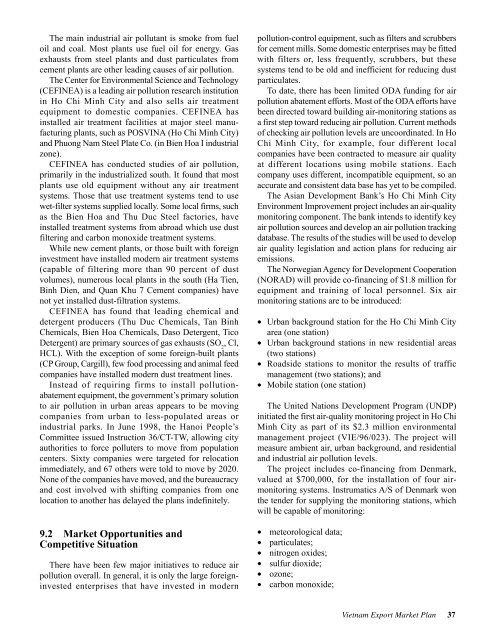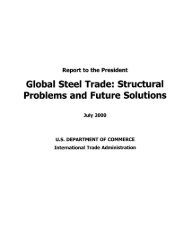Vietnam Environmental Technologies Export Market Plan
Vietnam Environmental Technologies Export Market Plan
Vietnam Environmental Technologies Export Market Plan
Create successful ePaper yourself
Turn your PDF publications into a flip-book with our unique Google optimized e-Paper software.
The main industrial air pollutant is smoke from fuel<br />
oil and coal. Most plants use fuel oil for energy. Gas<br />
exhausts from steel plants and dust particulates from<br />
cement plants are other leading causes of air pollution.<br />
The Center for <strong>Environmental</strong> Science and Technology<br />
(CEFINEA) is a leading air pollution research institution<br />
in Ho Chi Minh City and also sells air treatment<br />
equipment to domestic companies. CEFINEA has<br />
installed air treatment facilities at major steel manufacturing<br />
plants, such as POSVINA (Ho Chi Minh City)<br />
and Phuong Nam Steel Plate Co. (in Bien Hoa I industrial<br />
zone).<br />
CEFINEA has conducted studies of air pollution,<br />
primarily in the industrialized south. It found that most<br />
plants use old equipment without any air treatment<br />
systems. Those that use treatment systems tend to use<br />
wet-filter systems supplied locally. Some local firms, such<br />
as the Bien Hoa and Thu Duc Steel factories, have<br />
installed treatment systems from abroad which use dust<br />
filtering and carbon monoxide treatment systems.<br />
While new cement plants, or those built with foreign<br />
investment have installed modern air treatment systems<br />
(capable of filtering more than 90 percent of dust<br />
volumes), numerous local plants in the south (Ha Tien,<br />
Binh Dien, and Quan Khu 7 Cement companies) have<br />
not yet installed dust-filtration systems.<br />
CEFINEA has found that leading chemical and<br />
detergent producers (Thu Duc Chemicals, Tan Binh<br />
Chemicals, Bien Hoa Chemicals, Daso Detergent, Tico<br />
Detergent) are primary sources of gas exhausts (SO 2<br />
, Cl,<br />
HCL). With the exception of some foreign-built plants<br />
(CP Group, Cargill), few food processing and animal feed<br />
companies have installed modern dust treatment lines.<br />
Instead of requiring firms to install pollutionabatement<br />
equipment, the government’s primary solution<br />
to air pollution in urban areas appears to be moving<br />
companies from urban to less-populated areas or<br />
industrial parks. In June 1998, the Hanoi People’s<br />
Committee issued Instruction 36/CT-TW, allowing city<br />
authorities to force polluters to move from population<br />
centers. Sixty companies were targeted for relocation<br />
immediately, and 67 others were told to move by 2020.<br />
None of the companies have moved, and the bureaucracy<br />
and cost involved with shifting companies from one<br />
location to another has delayed the plans indefinitely.<br />
9.2—<strong>Market</strong> Opportunities and<br />
Competitive Situation<br />
There have been few major initiatives to reduce air<br />
pollution overall. In general, it is only the large foreigninvested<br />
enterprises that have invested in modern<br />
pollution-control equipment, such as filters and scrubbers<br />
for cement mills. Some domestic enterprises may be fitted<br />
with filters or, less frequently, scrubbers, but these<br />
systems tend to be old and inefficient for reducing dust<br />
particulates.<br />
To date, there has been limited ODA funding for air<br />
pollution abatement efforts. Most of the ODA efforts have<br />
been directed toward building air-monitoring stations as<br />
a first step toward reducing air pollution. Current methods<br />
of checking air pollution levels are uncoordinated. In Ho<br />
Chi Minh City, for example, four different local<br />
companies have been contracted to measure air quality<br />
at different locations using mobile stations. Each<br />
company uses different, incompatible equipment, so an<br />
accurate and consistent data base has yet to be compiled.<br />
The Asian Development Bank’s Ho Chi Minh City<br />
Environment Improvement project includes an air-quality<br />
monitoring component. The bank intends to identify key<br />
air pollution sources and develop an air pollution tracking<br />
database. The results of the studies will be used to develop<br />
air quality legislation and action plans for reducing air<br />
emissions.<br />
The Norwegian Agency for Development Cooperation<br />
(NORAD) will provide co-financing of $1.8 million for<br />
equipment and training of local personnel. Six air<br />
monitoring stations are to be introduced:<br />
• Urban background station for the Ho Chi Minh City<br />
area (one station)<br />
• Urban background stations in new residential areas<br />
(two stations)<br />
• Roadside stations to monitor the results of traffic<br />
management (two stations); and<br />
• Mobile station (one station)<br />
The United Nations Development Program (UNDP)<br />
initiated the first air-quality monitoring project in Ho Chi<br />
Minh City as part of its $2.3 million environmental<br />
management project (VIE/96/023). The project will<br />
measure ambient air, urban background, and residential<br />
and industrial air pollution levels.<br />
The project includes co-financing from Denmark,<br />
valued at $700,000, for the installation of four airmonitoring<br />
systems. Instrumatics A/S of Denmark won<br />
the tender for supplying the monitoring stations, which<br />
will be capable of monitoring:<br />
• meteorological data;<br />
• particulates;<br />
• nitrogen oxides;<br />
• sulfur dioxide;<br />
• ozone;<br />
• carbon monoxide;<br />
<strong>Vietnam</strong> <strong>Export</strong> <strong>Market</strong> <strong>Plan</strong><br />
37
















